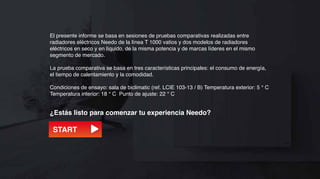
Radiadores eléctricos comparativos Needo T1000W
- 1. El presente informe se basa en sesiones de pruebas comparativas realizadas entre radiadores eléctricos Needo de la línea T 1000 vatios y dos modelos de radiadores eléctricos en seco y en líquido, de la misma potencia y de marcas líderes en el mismo segmento de mercado. La prueba comparativa se basa en tres características principales: el consumo de energía, el tiempo de calentamiento y la comodidad. Condiciones de ensayo: sala de biclimatic (ref. LCIE 103-13 / B) Temperatura exterior: 5 ° C Temperatura interior: 18 ° C Punto de ajuste: 22 ° C ¿Estás listo para comenzar tu experiencia Needo? START
- 2. 1/4 CONSUMO DE ENERGÍA 1400 Condiciones de ensayo: sala de biclimatic (ref. LCIE 103-13 / B). Temperatura exterior: 5 ° C - Temperatura interior: 18 ° C - Punto de ajuste: 22 ° C -25% 1200 1000 El consumo de energía es la energía real absorbida por cada sistema y se mide con un vatímetro. 1366 Wh El período de prueba se refiere a un tiempo de subida [Watt/hora] 800 1118 Wh de 2 horas. 1015 Wh 600 ¡NEEDO GANA! 400 CONSUMO DE -25% Needo 200 ENERGÍA A B 0 0,0 0,10 0,20 0,30 0,40 0,50 1,00 1,10 1,20 1,30 1,40 1,50 2,00 [hora - minutos] 22° C 5°C 18°C test en 18° C reglamento 2 horas condiciones electrónico normales nativo A B Needo
- 3. 2/4 TIEMPO DE CALENTAMIENTO 23° 1,5x velocidad Condiciones de ensayo: sala de biclimatic (ref. LCIE 22,5° 56 min 103-13 / B). Temperatura exterior: 5 ° C - Temperatura interior: 18 ° C - Punto de ajuste: 22 ° C 22° 21,5° El punto de ajuste era de 22 ° C para todos los A sistemas.El tiempo se refiere al período (minutos) [Temperatura] 21° requeridos por cada sistema para alcanzar el punto de 20,5° ajuste en las mismas condiciones de trabajo. 20° B 19,5° ¡NEEDO GANA! 19° velocidad +150% 18,5° TIEMPO PARA 18° EL PUNTO DE Needo 0,0 0,10 0,20 0,30 0,40 0,50 1,00 1,10 1,20 1,30 AJUSTE [hora - minutos] 56 min NEEDO 22° C 5°C 18°C 1h 09 min B test en 18° C 1h 26 min C condiciones normales
- 4. 3/4 PERFIL DE TEMPERATURA Condiciones de ensayo: sala de biclimatic (ref. LCIE 103-13 / B). Temperatura exterior: 5 ° C - Temperatura t °C interior: 18 ° C - Punto de ajuste: 22 ° C ∆T 4°C Los sistemas fueron funcionando a máxima potencia t °C hasta el estado estable de la temperatura, alcanzado en la superficie frontal de los calentadores. NEEDO t °C ¡NEEDO GANA! ∆T 25°C ∆t max 4°C t °C CONFORT B t °C ∆T 15°C t °C C
- 5. 4/4 SISTEMA DE CONDENSACIÓN AVANZADO 1 2 3 4 1. Una pequeña cantidad de líquido ACS ® integrado en el núcleo del sistema se calienta desde el calentador eléctrico colocado en la parte inferior. 2. En los primeros 15 segundos el líquido se evapora y se expande en el interior del radiador a muy alta velocidad. 3. El líquido se evapora inmediatamente creando una fina capa de condensación, ya que entra en contacto con la superficie interior del radiador. 4. Durante el proceso de condensación el calor se transfiere al dispositivo y se libera en la habitación a través de una distribución uniforme de la temperatura. El líquido condensado se recoge en la parte inferior para reiniciar un nuevo ciclo de ACS ®. 0 seg 15 seg 30 seg 60 seg
